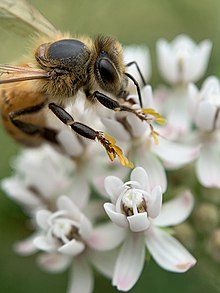| Asclepias angustifolia | |
|---|---|

| |
| Scientific classification | |
| Kingdom: | Plantae |
| Clade: | Tracheophytes |
| Clade: | Angiosperms |
| Clade: | Eudicots |
| Clade: | Asterids |
| Order: | Gentianales |
| Family: | Apocynaceae |
| Genus: | Asclepias |
| Species: | A. angustifolia |
| Binomial name | |
| Asclepias angustifolia Schweigg. | |


Asclepias angustifolia, commonly called the Arizona milkweed, is an endemic species of milkweed native only to Arizona.
Description
The Arizona milkweed is an herbaceous perennial that forms a taproot, growing to 28 in (71 cm) in height. The stems arise from a single crown, and can be many.
Leaves - opposite, linear with short petioles, glabrous, 4–12 cm (1.6–4.7 in) in length, 2–11 mm (0.079–0.433 in) in width; Inflorescence - 2–4 cm (0.79–1.57 in), erect umbel, single peduncle per node, with one or more peduncles per stem, typically borne towards the top of the stem; Flowers - 3 mm (0.12 in) in diameter and in length, pedicels 5 mm (0.20 in), horns extend beyond the hoods, corollas reflexed, flower color ranges from whitish to pink; Pods - slender, upright, 3.5–9 cm (1.4–3.5 in) long, containing few to many seeds; Seeds - ca. 4mm in length, attached to white silky coma c. 4 mm (0.16 in) in length.
Ecology
Found at higher elevations (around 1,050 to 2,100 metres ), it is known only from Pima, Santa Cruz, and Cochise counties in Arizona, United States. Native substrate mostly consists of dry rocky soils. Habit includes riparian woodlands, floodplain meadows, cienega edges, canyons, and arroyo bottoms. It is considered rare in Arizona, and restricted to the borderlands. This species is a known host plant to the Monarch Butterfly. Because it serves as a nesting ground for the Monarch's larvae, it is a vital component in preventing the extinction of these butterflies. It has been observed to be pollinated by small species of Carpenter Bees (Ceratina sp.).
Cultivation
The Arizona milkweed is commercially available by both seed and propagated plants. Seed readily germinates, and mature flowering plants can be grown in as little as three months. Plants can be successfully grown in containers as small as a quart. This species is tolerant of excess watering and lack of watering, in which substrate has not been seen to be an important factor in growth. Substrates utilized have been both organic-rich and replacement to sandy loam profiles. Cold hardiness has been noted to −12 °C (10 °F).
Pollination

Asclepias angustifolia pollination is performed mechanically by insects.
References
- ^ Pollinator Plants of the Desert Southwest, Native Milkweeds | https://www.nrcs.usda.gov/Internet/FSE_PLANTMATERIALS/publications/azpmctn12744.pdf
- "Asclepias angustifolia Schweigg". www.gbif.org. GBIF. Retrieved 2020-12-17.
- "Taxonomy browser (Asclepias angustifolia)". www.ncbi.nlm.nih.gov. National Center for Biotechnology Information. Retrieved 2020-12-17.
- "Lady Bird Johnson Wildflower Center - The University of Texas at Austin". www.wildflower.org. Retrieved 2024-08-17.
- "Asclepias angustifolia, Arizona Milkweed, Southwest Desert Flora". southwestdesertflora.com. Retrieved 2020-12-16.
- ^ "Asclepias angustifolia | Bring Back The Monarchs". Retrieved 2020-12-16.
- Fallon, Candace. "Milkweeds and Monarchs in the Western U.S." (PDF). monarchjoinventure.org. The Xerces Society for Invertebrate Conservation. Retrieved July 17, 2022.
- ^ Personal observations made by Pat Mahon - Pure Air Natives, St. Louis, MO - pat@pureairnatives.com
| Taxon identifiers | |
|---|---|
| Asclepias angustifolia | |